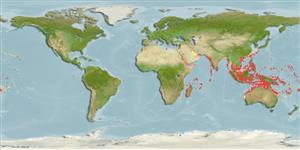分类 / Names
俗名 | 同种异名 | Catalog of Fishes(属, 种) | ITIS | CoL | WoRMS | Cloffa
Teleostei >
Eupercaria/misc (Various families in series Eupercaria)
鱸形目 (Various families in series Eupercaria) >
Labridae (Wrasses)
隆頭魚科 (Wrasses) > Cheilininae
Etymology: Cheilinus: Greek, cheilos = lip (Ref. 45335).
More on author: Bloch.
Environment: milieu / climate zone / depth range / distribution range
生态学
海洋 礁区鱼类; 深度上下限 4 - 80 m (Ref. 9823), usually 4 - 40 m (Ref. 27115). 熱帶; 23°C - 27°C (Ref. 27115); 32°N - 36°S, 24°E - 170°W
Indo-Pacific: from the east coast of Africa and islands of the western Indian Ocean to Micronesia and Samoa and Tonga; north to the Ryukyu Islands, Japan; south to Queensland, Australia.
印度-太平洋: 紅海而且東非到密克羅尼西亞與美屬薩摩亞, 北至琉球群島.(參考文獻 1602)
大小 / 重量 / 年龄
Maturity: Lm ? range ? - ? cm
Max length : 40.0 cm SL 雄鱼/尚未辨别雌雄; (Ref. 9823); 最大体重: 172.83 g (Ref. 124708)
背棘 (总数) : 9; 背的软条 (总数) : 10; 臀棘: 3; 臀鳍软条: 8. This species is distinguished by the following characters: body moderately deep, its depth 2.35 to 2.6 times in standard length; dorsal profile of head convex; anterior tip of snout forming an acute angle; jaws prominent, especially lower jaw in large individuals; strong canines 2, situated anteriorly in each jaw; no enlarged tooth present on rear of upper jaw; D IX,10, continuous with spines and anterior soft rays of similar length; A III, 8; pectoral fins with ii unbranched and 10 branched rays; pelvic fins short, not reaching anus; caudal fin rounded in juveniles, the upper and lower rays forming elongate lobes in large individuals, giving the fin a trilobed appearance. Lateral line interrupted below posterior portion of dorsal-fin base, with a total of 22-23 pored scales; scales reaching well onto bases of dorsal and anal fins; scales in front of dorsal fin extending forward to above anterior portion of eye; cheek and opercle scaly; lower jaw without scales (Ref. 9823). Colour of juveniles brown with 5 white bars across body, the first broadest and brightest, below third dorsal-fin spine, the second bar indistinct, on ventral half of body and the fifth is faint, anteriorly on caudal peduncle; all bars but the second extend onto dorsal and anal fins; 3 faint, short, greenish bars on nape and interorbital space; short, oblique, white or yellowish band from eye across preopercle; narrow white bar at base of caudal fin; large, dark blue spot, surrounded dorsally with orange, anteriorly in dorsal fin. Colour of subadults and females with similar white bars on nape and body as juveniles, but the second bar on lower body becoming more distinct and nearly reaching dorsal fin; there are few scales behind eyes and many scales on body with vertical indistinct dark streak; an orange area from behind eye and nape to pectoral-fin base; humeral area with 2 (sometimes a third above) double, rounded to nearly quadrangular, dark blue or black spots; head becoming olive with short orange-red lines radiating from eye; the lower body, dorsal and anal fins, and posterior half of caudal fin with small dark orange to red spots, only a few spots in fins in some individuals, sometimes median fins also with short red lines, similar to those radiating from eye; caudal fin is white with black bar in centre (bar not reaching upper and lower margins) and black posterior margin. Colour of males with similar color pattern but the suffusion of orange becoming bright orange-red, covering postorbital part of head, anterior of body (including anterior abdomen and chest), and pectoral-fin base, the area restricted posteriorly to the first white bar, not enclosing it; a second white bar across the body reaching dorsal fin; black streak on scales becoming broader and well-defined (Ref. 117607).
小的稚鱼时常被误认为 Wetmorella sp. 由于细的垂直白色条纹。 大的个体发育鲜红色区域而且雄鱼有扩大的尾鳍叶。 (参考文献 48636)
Adults inhabit lagoon and seaward reefs, usually in areas with mixed coral, sand, and rubble (Ref. 9710). Young common on silty reefs, usually along edges with algae-rubble and sand (Ref. 48636). Juveniles are secretive. Individuals often solitary and mainly on sand and rubble substrata near coral reefs, but more common in protected than exposed areas, generally at depths less than 20 m. (Ref. 117607). Feed mainly on benthic, hard-shelled invertebrates, including mollusks, crustaceans and sea urchins (Ref. 5374). Oviparous, distinct pairing during breeding (Ref. 205). Caught on hook-and-line with some frequency, this species is marketed in small numbers. Occasionally seen in the aquarium trade (Ref. 9823). Maximum depth reported taken from Ref. 128797.
栖息于泻湖与临海礁石, 通常在区域有混合的珊瑚,沙子与碎石。 (参考文献 9710) 主要吃底栖性,具有硬壳的无脊椎动物,包括软件动物,甲壳动物与海胆。 (参考文献 5374) 幼鱼常见于淤泥的礁, 通常沿着有藻类碎石与砂的边缘。 (参考文献 48636)
Life cycle and mating behavior
Maturities | 繁殖 | Spawnings | Egg(s) | Fecundities | 仔鱼
Oviparous, distinct pairing during breeding (Ref. 205).印度-太平洋: 紅海而且東非到密克羅尼西亞與美屬薩摩亞, 北至琉球群島.(參考文獻 1602)
Bogorodsky, S.V., T.J. Alpermann and A.O. Mal, 2016. Redescription of Cheilinus quinquecinctus Rüppell, 1835 (Pisces: Perciformes, Labridae), a valid endemic Red Sea wrasse. Zootaxa 4158(4):451-472. (Ref. 117607)
人类利用
渔业: 低经济; 水族馆: 商业性
工具
特别资料
下载 XML
网络资源
Estimates based on models
Preferred temperature (Ref.
123201): 24.7 - 29, mean 28 °C (based on 1620 cells).
Phylogenetic diversity index (Ref.
82804): PD
50 = 0.5078 [Uniqueness, from 0.5 = low to 2.0 = high].
Bayesian length-weight: a=0.01585 (0.00707 - 0.03555), b=2.95 (2.76 - 3.14), in cm total length, based on LWR estimates for this (Sub)family-body shape (Ref.
93245).
营养阶层 (Ref.
69278): 3.4 ±0.40 se; based on food items.
回复力 (Ref.
120179): 低的, 最小族群倍增时间4.5 - 14 年 (Preliminary K or Fecundity.).
Fishing Vulnerability (Ref.
59153): Moderate vulnerability (39 of 100).
Nutrients (Ref.
124155): Calcium = 38.5 [21.3, 85.9] mg/100g; Iron = 0.618 [0.276, 1.406] mg/100g; Protein = 17.6 [13.4, 21.0] %; Omega3 = 0.103 [0.059, 0.172] g/100g; Selenium = 35.3 [17.8, 77.5] μg/100g; VitaminA = 217 [41, 973] μg/100g; Zinc = 2.82 [1.59, 4.57] mg/100g (wet weight); based on
nutrient studies.
